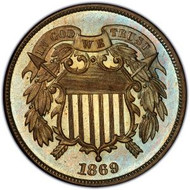In God We Trust and U.S. Currency
Posted by Bullion Shark on Mar 17th 2022
In God We Trust and U.S. Currency
In 1955 President Dwight D. Eisenhower signed legislation into law mandating that the national motto, “In God We Trust” appear on all U.S. coins and paper currency, though it took until the 1960s for it to appear on all dollar bills.
It first appeared on paper money in 1957 on $1 silver certificates. As the Bureau of Printing and Engraving updated its printing processes, the motto was added to the back side of all paper currency.
Religion has been at the center of the American experience since its founding, and a desire to practice their own religion is what inspired the Pilgrims to make the long voyage to our shores from England over 400 years ago. The Mayflower Compact included several references to God.
When Francis Scott Key wrote the Star Spangled banner during the War of 1812, he wrote: “And this be our motto: In God is Our Trust.”
But religion has also been an issue that has divided Americans since its founding. The U.S. Constitution, for example, is a secular document, and the first clause of the Bill of Rights, or the establishment clause, established a separation between church and state. On the other hand, most state constitutions included a reference to God.
During the Civil War, as if often the case during periods of national strife, religious sentiment in the country was rising and became an issue between the Confederacy and Union after the Articles of Confederation included a passage referencing “the favor of almighty God”. This led some people to question if the Union was godless. Both sides fought over which side was more Christian and more devout and whose side God was on.
Reaction to the Confederacy’s religious reference in its constitution was one of the motivations within the Union that eventually led to the placement of “In God We Trust” on U.S. coinage.
Moto emerges
During the war, letters were sent to the Treasury urging that God be referenced on our coinage. Mint Director James Pollock proposed that a motto to this effect be added to our coinage.
Treasury Secretary Salmon P. Chase proposed that the motto read “In God We Trust” and that it appear on the new two-cent coin, which it did in 1864.
Prior to that the motto appeared on various pattern coins dated 1961 to 1865 – some of which were issued officially and others which were not.
Since then, the motto has appeared on most U.S. coinage with some exceptions. In 1865 Congress passed a law requiring the motto appear on all silver and gold coins, starting with the gold eagle, double eagle and half eagle.
In 1866 it first appeared on silver coinage, specifically, the Shield nickel. It was then added to the silver dollar, half dollar, quarter and three-cent nickel coins. It has appeared on the cent since 1909 when the Lincoln penny was introduced and since 1916 when the Winged Liberty dime was introduced.
It has appeared on gold coins, silver dollars, half dollars and quarters struck since 1908.
In 1915 it first appeared on a commemorative coin when the coins for the Panama-Pacific Exposition were released.
However, when it comes to the nickel, the motto disappeared in 1883 with the Liberty nickel and did not reappear on nickels until 1938 when the Jefferson nickel was introduced. The motto has appeared on all U.S. coins issued since 1938.
In 1907 when the Saint-Gaudens $20 gold double eagle and eagle both debuted, the motto was missing, which led to an outcry and its reappearance in 1908 after Congress mandated it. That same year Congress mandated that any coins that previously had the motto had to include it in the future.
Modern controversies
In recent years there have been some controversies around the issue of the motto appearing or not appearing on our coinage.
In 2005 legislation was enacted that authorized the Presidential $1 coin series, the law included a provision that said the motto “In God We Trust” “shall be edge incused into the coin.” Some Americans were unaware the motto had been moved to the edge when these coins began appearing in change in 2007 on which also the date, mint mark and the inscription “E Pluribus Unum” had all been moved to the edge. This led to numerous complaints about “Godless dollars”.
But then it was discovered that some of the 2007 Washington dollars were struck without the edge inscriptions, which only compounded the problem. It turned out later that about 50,000 of a total of over 340 million of these coins lacked the edge inscriptions. They were initially considered valuable rarities until the actual number of errors was known, which brought the price down.
The Mint announced that it would correct the problem, but then more coins without the edge inscriptions were discovered among the John Adams coins, leading to more public outcry. By late 2007 Congress acted to address this issue by mandating that “In God We Trust” must appear on the obverse or reverse of future coins, which they did starting in 2009 when the William Henry Harrison dollar was released.
"In God We Trust" is clearly here to stay on U.S. coins and paper money.


